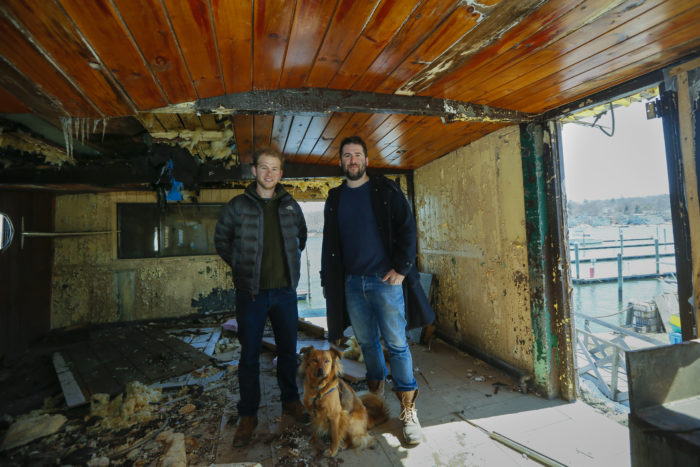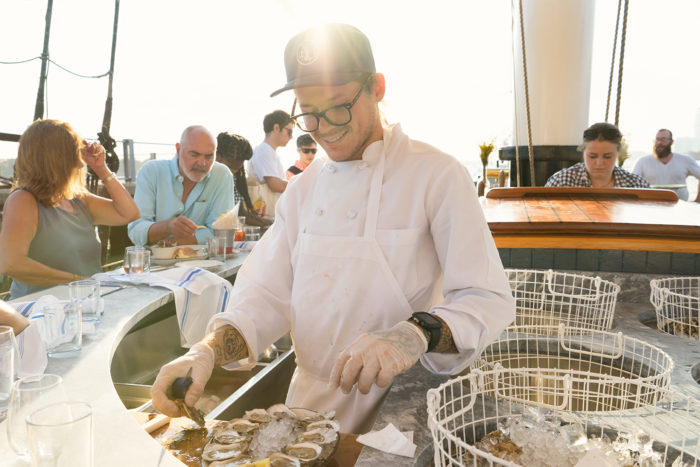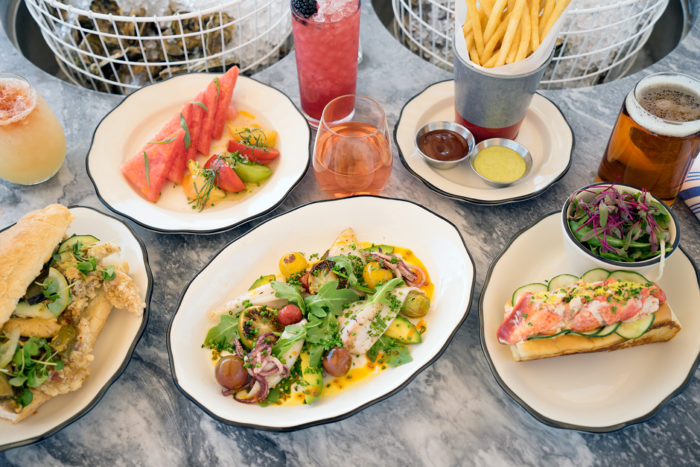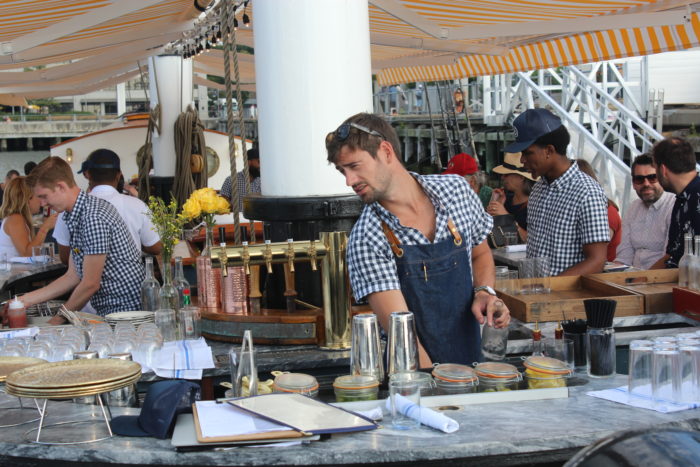Two Brothers Who Love Boats Launch a Restaurant Fleet
Pilot, anchored at Brooklyn Bridge Park, is just one of the oyster-inspired eateries from Alex and Miles Pincus
Pilot restaurant, aboard a nearly century-old schooner, is berthed at Pier 6 in Brooklyn Bridge Park (Photo courtesy of Pilot restaurant)
If you venture down to Brooklyn Bridge Park at Pier 6, you’ll see a typical late-summer scene: people on bicycles, children playing in the Water Lab, and plenty of lounging. However, once you get closer to the water, you’ll see something a little more startling: a beautiful wooden schooner that looks like it’s straight out of the 1920s, which indeed it is. But the boat isn’t just a floating museum piece that happened to berth for the night. It’s a restaurant and bar called Pilot, named after the ship herself. How Pilot arrived is a story about a pair of brothers who made a business out of two of their obsessions: old boats and oysters.
Pilot is among a growing fleet of restaurants launched by Alex and Miles Pincus, who grew up in New Orleans and now reside in Brooklyn. Their first was Grand Banks, an oyster bar aboard a 1940s-era fishing schooner, the Sherman Zwicker, which they opened in 2014 at Pier 25 in Tribeca and quickly became lauded for its oysters, its lobster roll and its maritime setting. Last year, the brothers opened a seafood restaurant in New Orleans, Seaworthy, in a partnership with the local outpost of the Ace Hotel.
This summer came two more: Pilot, which opened earlier this month, and Island Oyster, a sprawling, casual waterfront bar on Governor’s Island. Yet what might look like ambitious expansion drive wasn’t exactly a grand plan, Alex admits. “When we did Grand Banks, we weren’t actively restaurant people, but we had a sense of what we wanted to do and it just kind of felt natural, so we kept going with it.”

Miles and Alex Pincus aboard one of their maritime restoration projects (Photo by ÁngelFranco/The New York Times/Redux)
Before they were restaurateurs, the brothers were actively pursuing other careers. Alex, an award-winning architect, co-founded the firm Bureau V, whose projects included National Sawdust, the Williamsburg concert hall. Miles, a competitive sailor with a master’s degree from New York Maritime College, partnered with Alex to found Atlantic Yachting, a sailing school and charter company. Yet the hospitality business runs in the family. “Our dad ran restaurants and hotels in New Orleans. We sort of spent our whole childhood just running around that stuff while it was happening. So I think that there’s the osmosis effect,” said Alex. “We grew up in hotels. We thought it was normal,” Miles told the New Orleans Advocate. “I thought everyone had a really charming maitre d’ around all the time.”
The journey to the restaurant business began with a love of boats. “We’re just always looking for old boats and we have a handful of them, unfortunately,” said Alex. “You know, some people are into watches and some people are into cars. We’re into boats.” When they set their sights on the Sherman Zwicker for their first restaurant, they chose a beauty, a 142-foot schooner built for cod fishing and the last of hundreds of such boats that once worked the North Atlantic.

An oyster shucker at Pilot restaurant presents a fresh array (Photo courtesy of Pilot)
While they knew their way around boats, the brothers weren’t professional chefs, so they teamed with Kerry Heffernan, who had been executive chef at the renowned Eleven Madison Park and worked with restaurant mogul Danny Meyer on the original menu for Meyer’s Shake Shack chain. The focus on oysters and seafood was a natural, given the brothers’ childhood on the Gulf. Today, they’re big advocates of sustainable seafood, supporting projects like the Billion Oyster Project to restore some of New York Harbor’s once-teeming oyster beds.
Envisioning the Pilot as a future restaurant, however, took some imagination. The boat was “kind of rotting away in a marina in Gloucester [Mass.] when we found it,” Alex recalls. “We kind of stumbled across it at one point when we were looking for something else and it wasn’t an immediate love at first sight kind of thing,” said Alex. “When you find one of these boats, it’s covered with tarps and everything’s piled with all kinds of miscellaneous stuff, so it’s sort of hard to see what you’re really looking at. But we kept thinking about it, and then I went back to visit a few times and started to see underneath everything that it was actually really beautiful.”

Besides oysters, Pilot’s menu includes a soft-shell-crab po’ boy, a lobster roll and a tomato-and-watermelon salad (Photo courtesy of Pilot)
It also had a colorful history. “This boat was built outside of Boston in the 20s. It was supposed to be the fastest sailboat in the world when they built it. It was built to be a racing boat,” said Alex. The boat ended up becoming a pilot ship, which ferries people from shore to larger ships at anchor, serving about 50 years. Later it became a research vessel, circumnavigating the world a couple times and carrying such scientific luminaries as Jacques Cousteau. Then it fell into disrepair.
The restoration took a year and a half. “It had a lot of rotten wood and it’s a historic boat, so you can’t just go buy the parts that you need. We have a pretty big crew of shipwrights on our team that we’ve been working with for a long time. We rebuilt the deck, a lot of the underside of the boat and then, since we’re operating as a restaurant, we had to figure out all of the infrastructure and build all of that too.” Once the boat was seaworthy again, the brothers sailed it from Gloucester to New York, where they’d leased a berth on Pier Six from the Brooklyn Bridge Park Conservancy. “We had been talking to them for quite a long time about doing this project and it was a long courtship,” said Alex.

The staff aboard Pilot has to roll with the waves (Photo by Arden Phillips)
Operating a restaurant at dockside has other problems to solve. “Floating presents a lot of challenges,” said Alex. “One, we’re moving around. But also we go up or down a good eight or ten feet every eight hours with the tide. So literally, all of our infrastructure and the way you get on the boat is always changing.” The boat’s electrical supply and other utilities don’t have the same capacity that a land-based restaurant would, so the food and beverage offerings have to be limited accordingly. “We’re not connected to the grid like most people are, so it’s very different operationally from being in a normal building,” said Alex. Plus, kitchen operations are below deck in a confined space. “It’s like a maze, but it’s fun and the constraints help us focus in on what we really want to serve. We don’t have a 40-page menu.”
Working on a boat is different for the staff too. Customers can sit down, but waiters and bartenders walk the deck on a ship that rolls noticeably when a passing boat leaves a large wake. Yet the working atmosphere has its attractions. “There are a lot of people that we get who feel that this layer of being on a boat feels good,” said Alex. “It’s nice to work outside and it doesn’t feel like a burden to go to work.”
For patrons, the crowning touch is the view: the Manhattan skyline, the sunset, the parade of boats cruising past in a busy harbor. On a recent night, a 700-ft. container ship, the Violet, made a 180-degree pirouette in front of the pier, spun by two tugboats as it made its way out to sea. You’ll never see a floor show like that in a landlubber restaurant.










